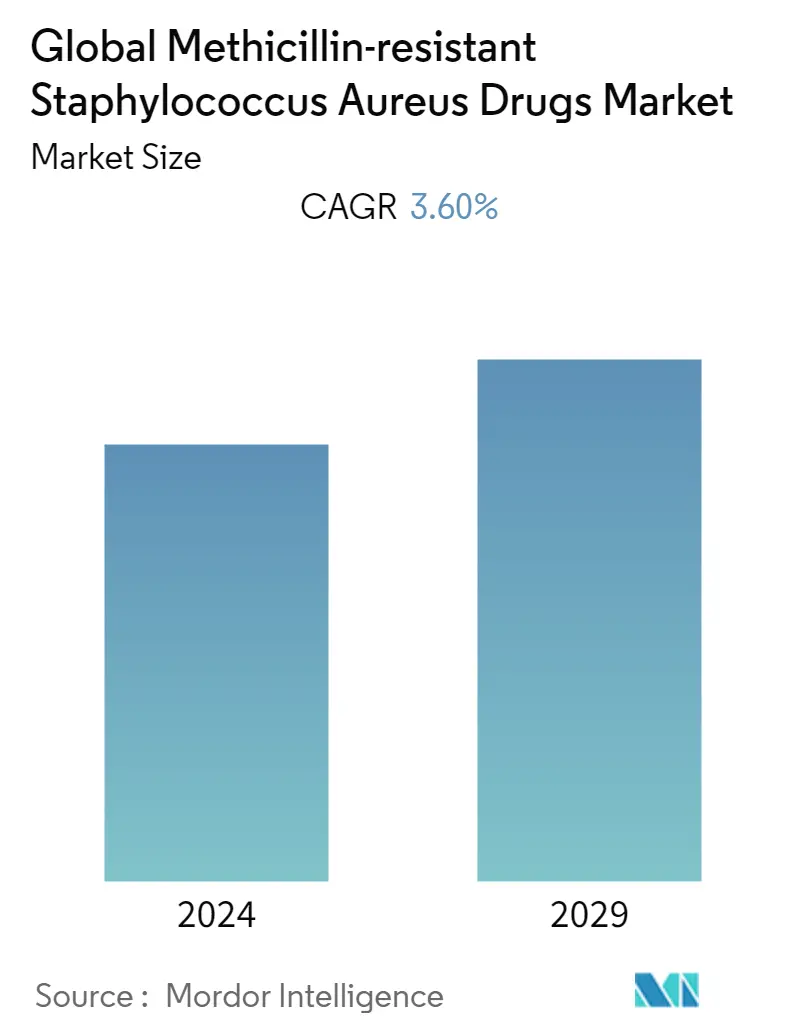Market Size of Global Methicillin-resistant Staphylococcus Aureus Drugs Industry

| Study Period | 2019 - 2029 |
| Base Year For Estimation | 2023 |
| Forecast Data Period | 2024 - 2029 |
| CAGR | 3.60 % |
| Fastest Growing Market | Asia Pacific |
| Largest Market | North America |
Major Players
*Disclaimer: Major Players sorted in no particular order |
Need a report that reflects how COVID-19 has impacted this market and its growth?
Methicillin Resistant Staphylococcus Aureus Drugs Market Analysis
The Methicillin-resistant Staphylococcus Aureus Drugs Market is expected to register a growth at a CAGR of 3.6% during the forecast period.
The global healthcare system has faced unprecedented challenges as a result of the coronavirus disease 2019 (COVID-19) pandemic, with opportunistic and secondary infections being one of the most serious issues. Due to exposure to multidrug-resistant organisms in healthcare facilities, the majority of secondary infections develop as nosocomial infections. According to the study "Impact of the COVID-19 Pandemic on the Incidence of Multidrug-Resistant Bacterial Infections in an Acute Care Hospital in Brazil" published in "American Journal of Infection Control" in September 2021, researchers identified 8,869 healthcare-associated infections (HCAI) caused by multidrug-resistant (MDR) bacteria that contributed to the higher mortality rate in Brazil. According to the findings, out of 8,869 HCAIs, of which 2,641 (29.7%) were caused by multidrug-resistant (MDR), and 1,257 (14.1%) were from ICUs. The overall incidence density (ID) of MDR infections increased by 23% during COVID-19. The total per-pathogen study reveals large increases in methicillin-resistant Staphylococcus aureus (MRSA) infections (+94.7%) and carbapenem-resistant Acinetobacter baumannii (CRAB) infections (+108.1%). In the ICU, the overall ID of MDR infections decreased during COVID, but that decline was not significant. The ICU per-pathogen analysis of ID of infection showed significant increases in CRAB and MRSA i.e. +42.0%, and +46.2% respectively. Therefore, the COVID-19 pandemic correlates to an increase in the ID of MRSA both in ICU and non-ICU settings. Thus, the possible outbreaks of MRSA in hospital settings are expected to create lucrative opportunities for the global Methicillin-resistant Staphylococcus Aureus Drugs market growth in the studied period.
The key factors attributing to the growth of the Methicillin-resistant Staphylococcus Aureus (MRSA) drugs market are a rise in the global prevalence of MRSA infections. According to the study "Methicillin-Resistant Staphylococcus Aureus" published in July 2021, the study indicated that MRSA appears to increase mortality and morbidity in geriatric people, nursing home patients, and people with organ dysfunction. People with end-stage liver disease, renal disease, and those hospitalized in the ICU have a significant chance to get hospital-associated MRSA. As per the findings, depending on the patient group and infection site, fatality rates range from 5 to 60%. Furthermore, researchers concluded that despite having no healthcare risks, over 60% of patients get MRSA within 48 hours of hospitalization. Hence, these factors are expected to increase the demand for MRSA drugs, in turn, it will create lucrative opportunities for the taget market growth in the given timeframe.
However, in developing countries, a lack of comprehensive surveillance for MRSA infection is expected to limit the market growth for MRSA drugs during the forecast period.
